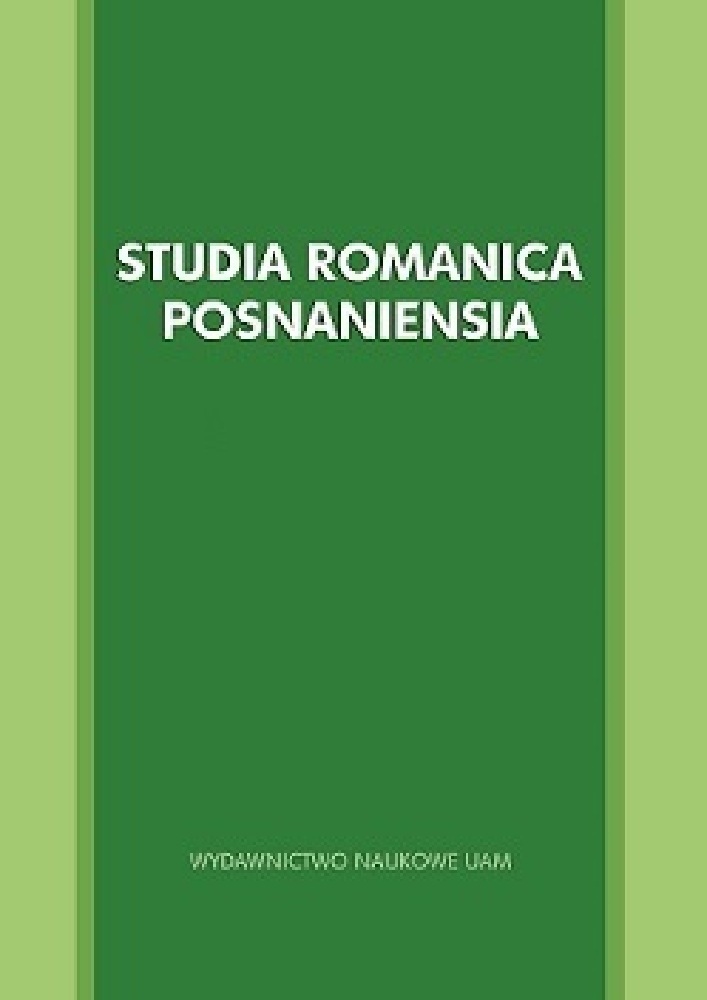Abstrakt
The aim of the paper is to identify the methods of teaching academic discourse in French on the example of a selected written text whose subject matter is concerned with linguistics in connection with other disciplines. The analysis uses as its starting point the assumptions of the theory of the linguistic image of the world (J. Bartmiński) and of the cognitive linguistics (G. Lakoff and M. Johnson, R.W. Langacker) as applied in glottodidactics. While reading and understanding a written text, students activate the process of schematization (abstraction) and categorization/recategorization (R.W. Langacker). Teacher’s role is to explain specialized lexis to students and make an attempt with them to analyse scientific texts from an interdisciplinary perspective. It is also important to familiarize students with the editorial rules applicable to diploma dissertations, both bachelor’s and master’s in French as well as the criteria of textuality, in-cluding cohesion, coherence, intentionality, acceptability, informativity, situationality, and intertextuality (R.A. De Beaugrande, W.U. Dressler).
Bibliografia
Bartmiński, J. (2007). Językowe podstawy obrazu świata. Lublin : Wydawnictwo Uniwersytetu Marii Curie-Skłodowskiej.
Causa, M. (2009). Enseignement d’une LE et d’une DNL : mettre en place une « compétence discursive » dans la production écrite de niveau avancé. Synergies Roumanie, 4, 179-188.
Causa, M. (2014). Compétence discursive et enseignement d’une discipline non linguistique : définition, diversification et pratiques formatives. Les Carnets du Cediscor, 12, 115-137. https://doi.org/10.4000/cediscor.964.
Charolles, M. (2003). Discours. In O. Houdé, D. Kayser, O. Koenig, J. Proust & F. Rastier (dir.), Vocabulaire de sciences cognitives (pp. 155-159). Paris : PUF.
Delbecque, N. (2010). Linguistique cognitive. Comprendre comment fonctionne le langage. Bruxelles : De Boeck-Duculot.
Douglas, M. (2004). Comment pensent les institutions ? Paris : La Découverte.
Gorczyca, W. (2007). Kognitywizm w glottodydaktyce. Wykłady. Bielsko-Biała : Wydawnictwo Akademii Techniczno-Humanistycznej.
Lakoff, G., Johnson, M. (1986). Les Métaphores dans la vie quotidienne. Paris : Les Éditions de Minuit.
Lakoff, G., Johnson, M. (1980). Metaphors We Live By. Chicago, London.
Langacker, R.W. (2003). Model dynamiczny oparty na uzusie językowym. In E. Dąbrowska, W. Kubiński (dir.), Akwizycja w ś wietle językoznawstwa kognitywnego (pp. 28-115). Kraków : Towarzystwo Autorów i Wydawców Prac Naukowych Universitas.
Marlot, C., Toullec-Thery, M., Daguzon, M. (2017). Processus de co-construction et rôle de l’objet biface en recherche collaborative. Phronesis, 6 (1–2), 21–34. https://doi.org/10.7202/1040215ar.
Moirand, S., (1982). Enseigner à communiquer en langue étrangère, Hachette, coll. F.
Morrissette, J. (2012). Quelques ficelles du métier de chercheur collaboratif. Recherches qualitatives, Hors-série n°13, les enjeux méthodologiques des recherches participatives, 5-19.
Pirogowska, E. (2017). Enseigner l’analyse du discours en langue étrangère. En quoi consiste le cours de spécialisation en linguistique destiné aux étudiants du 2nd cycle ? Studia Romanica Posnaniensia, 44 (2), 113-124.
Rutka, K. (2010) Glottodydaktyczne aspekty kognitywnego ujęcia metafory. In K. Rutka, Metafora w glottodydaktyce. https://www.phil.muni.cz/journal/proudy/filologie/materialy/2010/3-4/Glottodydaktyczne-aspekty.php [accès : 22.04.2021].
Santarpia, A., Blanchet, A., Venturini, R., Cavallo, M., Raynaud, S. (2006). La catégorisation des métaphores conceptuelles du corps. Annales Médico-Psychologiques, 164, 476-485. https://www.researchgate.net/publication/246564586_La_categorisation_des_metaphores_conceptuelles_du_corps [accès : 21.02.2021]. https://doi.org/10.1016/j.amp.2005.01.0.
Taylor, J.R. (2001). Kategoryzacja w języku. Prototypy w teorii językoznawczej. Trad. A. Skucińska.Kraków : Towarzystwo Autorów i Wydawców Prac Naukowych Universitas.
Licencja
- Autor oświadcza, że przysługują mu osobiste i majątkowe prawa autorskie do Utworu oraz że nie są one ograniczone w zakresie objętym niniejszą Umową, oraz że utwór jest dziełem oryginalnym i nie narusza majątkowych lub osobistych praw autorskich innych osób.
- Autor udziela Uniwersytetowi im. Adama Mickiewicza w Poznaniu niewyłącznej i nieodpłatnej licencji na korzystanie z Utworu bez ograniczeń terytorialnych i przez czas nieokreślony na następujących polach eksploatacji:
2.1. wytwarzanie określoną techniką egzemplarzy Utworu, w tym techniką drukarską, reprograficzną, zapisu magnetycznego oraz techniką cyfrową;
2.2. wprowadzanie do obrotu, użyczenie lub najem oryginału albo egzemplarzy Utworu;
2.3. publiczne wykonanie, wystawienie, wyświetlenie, odtworzenie oraz nadawanie i reemitowanie, a także publiczne udostępnianie Utworu w taki sposób, aby każdy mógł mieć do niego dostęp w miejscu i w czasie przez siebie wybranym;
2.4. włączenie Utworu w skład utworu zbiorowego;
2.5. wprowadzanie Utworu w postacie elektronicznej na platformy elektroniczne lub inne wprowadzanie Utworu w postaci elektronicznej do Internetu, Intranetu, Extranetu lub innej sieci;
2.6. rozpowszechnianie Utworu w postaci elektronicznej w Internecie, Intranecie, Extranetu lub innej sieci, w pracy zbiorowej jak również samodzielnie;
2.7. udostępnianie Utworu w wersji elektronicznej w taki sposób, by każdy mógł mieć do niego dostęp w miejscu i w czasie przez siebie wybranym, w szczególności za pośrednictwem Internetu, Intranetu, Extranetu lin innej sieci;
2.8. udostępnianie Utworu zgodnie z wzorcem licencji Attribution-NonCommercial-ShareAlike 4.0 International (CC BY-NC-SA 4.0) lub innej wersji językowej tej licencji lub którejkolwiek późniejszej wersji tej licencji, opublikowanej przez organizację Creative Commons. - Autor zezwala Uniwersytetowi im. Adama Mickiewicza w Poznaniu na:
3.1. nieodpłatne korzystanie i rozporządzanie prawami do opracowań Utworu i tymi opracowaniami.
3.2. wysyłanie metadanych Utworu oraz Utworu do komercyjnych i niekomercyjnych baz danych indeksujących czasopisma. - Autor upoważnia i zobowiązuje Uniwersytet im. Adama Mickiewicza w Poznaniu do udzielania osobom trzecim dalszych licencji (sublicencji) do Utworu oraz do innych materiałów, w tym utworów zależnych lub opracowań zawierających lub powstałych w oparciu o Utwór, przy czym postanowienia takich sublicencji będą tożsame z wzorcem licencji Attribution-NonCommercial-ShareAlike 4.0 International (CC BY-NC-SA 4.0) lub innej wersji językowej tej licencji lub którejkolwiek późniejszej wersji tej licencji, opublikowanej przez organizację Creative Commons Tym samym uprawnia wszystkich zainteresowanych do korzystania z utworu wyłącznie w celach niekomercyjnych pod następującymi warunkami:
4.1. uznanie autorstwa czyli obowiązek podania wraz z rozpowszechnionym utworem informacji, o autorstwie tytule, źródle (odnośniki do oryginalnego utworu, doi) oraz samej licencji;
4.2. na tych samych warunkach, wolno rozpowszechniać utwory zależne jedynie na licencji identycznej to tej, na jakiej udostępniono utwór oryginalny. - Uniwersytet im. Adama Mickiewicza w Poznaniu jest zobowiązany do:
5.1. udostępniania Utworu w taki sposób, aby każdy mógł mieć do niego dostęp w miejscu i w czasie przez siebie wybranym bez ograniczeń technicznych;
5.2. poprawnego informowania osób, którym Utwór będzie udostępniany o udzielonych im sublicencjach w sposób umożliwiający odbiorcom zapoznanie się z nimi.
Pozostałe postanowienia
- Uniwersytet im. Adama Mickiewicza w Poznaniu zachowuje prawo do czasopisma jako całości (układ, forma graficzna, tytuł, projekt okładki, logo itp.).

